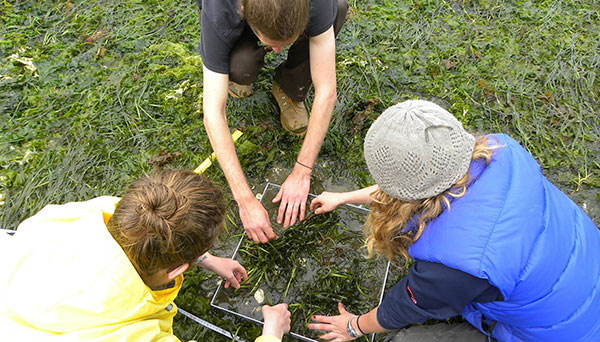Revitalization of Indigenous Place-based Conservation for Coastal Restoration
Organization: SeaChange Marine Conservation Society
SeaChange Marine Conservation Society’s mission is marine education, conservation and restoration of nearshores within the Salish Sea in collaboration with coastal communities in British Columbia, Canada.
Location: Sidney, British Columbia, Tseychum First Nations
Country: Canada
Other Organizations Involved: Peninsula Streams Society, Tseycum First Nations, University of Victoria Geography Dept., Coastal Ocean Resources, ShoreZone, Coastal Geologic Services, Inc.

©Leanna Boyer
Background
The Traditional Territory of the Tseycum First Nations of Roberts Bay and Tsehum Harbour is located in what is now known as Sidney, BC, Canada on the northern end of the Saanich Peninsula. The shores of these two culturally significant areas have lost vast areas of marine nearshore habitat and biodiversity from years of development and resulting impacts. Social and ecological consequences of broken ties between communities and in traditional cultural practices need to be restored as much as possible during climate changes, which are increasing annually. Fundamental to that recovery is forming a baseline of knowledge of what lived in these two bays before the impacts. Use of Traditional Ecological Knowledge in combination with Western technical science will create a baseline of cultural and ecological information that will inform present and future conservation and restoration actions.
Goals
- Plan for restoration of two shore sites in Tseycum Traditional Territory.
- Increase knowledge of Traditional Cultural Practices for Tseychum youth in these sites.
- Public education for the wider community to understand “Place” and its meaning to First Nations.
Main activities
- Creation of Indigenous and Western Science Ecological Baseline.
- Provide training in ecological marine conservation.
- Public education.
- Nearshore restoration.
Outcomes
- Archived Traditional Knowledge of two shore sites in digital and physical formats - accessibility based on permission by Tseycum First Nations.
- Public presentations to wider community of TEK based on permission of Tseycum First Nations.
- Restoration of shores based on surveys and site assessment and climate prediction models.
Environmental and Community Benefits from this project are presenting a longer-range perspective on the meaning of ecological baselines used for restoration of shorelines, and, potentially, a deeper comprehension by the wider community of what has been the legacy of development performed without an understanding of the cultural history and practices of surrounding Indigenous communities
The Main Beneficiaries of this project are the Tseycum Frist Nations and the wider community surrounding the two sites, including the Town of Sidney. Ultimately, this project could serve as an example of the process that can be undertaken, with respect, for more ecological baselines based both on Traditional Ecological Knowledge and on Western science.